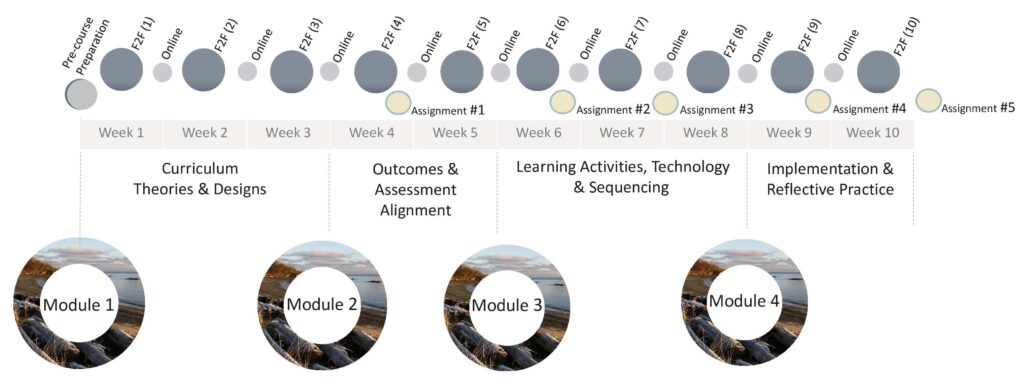What is blended learning?
How can you design an effective blended learning experience?
Blended Learning: A Definition
Blended learning is described in various ways, but fundamentally, it is an educational approach that combines the advantages of in-person and online learning environments. The aim is to create a cohesive and effective learning experience by thoughtfully integrating different teaching methods to meet learners’ diverse needs and preferences. VIU defines blended delivery as a combination of face-to-face and online interactions. The online components can be asynchronous or synchronous, allowing students to engage with the content at their own pace or during scheduled times. According to the Office for Students (2022), blended learning is the strategic integration of traditional and digital teaching and learning methods, aligning with the aspirations of 21st-century education.

Blended Learning Ad Hoc Committee
One of the goals outlined in VIU Trades and Applied Technology’s (TAT) Draft Strategic Plan is to provide diverse teaching and learning delivery modes. To achieve this, the TAT Blended Learning Ad Hoc (BLAH) Committee explores ways of supporting blended learning. The committee has set the following objectives:
- define blended teaching and learning,
- discuss opportunities and aspirations for blended delivery to evaluate best practices, and
- recommend a decision-making process to support the effective design, adoption, and implementation of blended learning.
Benefits of Blended Learning
Blended learning offers numerous benefits to both students and instructors, as highlighted by the University of Manitoba :
Benefits for students:
- Collaborative learning: possibility to discuss course material online and face-to-face;
- Flexible access to the course material (time and place);
- Learn at their own pace;
- Help to overcome the sense of isolation many students feel when doing fully online courses; and
- Reduction of costs for students by decreasing travel expenses, etc.
Benefits for instructors:
- Positive experience and attitude of their students towards technology-mediated teaching and learning;
- Schedule flexibility and more time to reflect in online discussions;
- Redesign teaching and learning approaches in ways that realize increased efficiency and convenience; and
- Better ways to address the multiple needs of learners.
How to Design a Blended Learning Course
When designing a blended learning course, instructors should consider the following questions, as suggested by Garrison and Vaughan (2008):
- What do you want your students to know when they have completed the blended learning course?
- What types of learning activities will you design that integrate face-to-face and online components? Blended learning is not just a matter of transferring a portion of your current course online. Instead, it involves developing challenging and engaging learning activities that occur within and outside of the classroom.
- How will you assess these integrated learning activities?
- How will the information and communication technologies be used to support blended learning?
The “Top Tips for Blended Learning” further expands on these questions and provides quality standards to guide the design of blended learning courses. You can access the Quality Standards Checklist by downloading the linked document.
Adopting Blended Learning
Blended learning definitions are inconsistent, leading to uncertainty among administrators, faculty, and students (Graham et al., 2023). To enhance clarity, course providers should ensure applicants can access clear information regarding the specific blended learning approach adopted for each course they are applying to. This information should include the ratio of face-to-face and online components, providing prospective students with a comprehensive understanding of the different learning modalities they will experience in each course. Additionally, enrolled students should receive a course map outlining the blended approaches used (Office for Students, 2022).

Communication Guide for VIU Trades and Applied Technology (TAT)
The BLAH committee has developed a communication guide and checklist to support your blended learning initiatives. In May 2023, BLAH proposed the “Communicating Blended Learning” document to effectively communicate the specific blend of your course(s). We kindly request your review and input on the approach. Please take a moment to review the proposed “Communicating Blended Learning” document and “Top Tips” guide, and provide us with your valuable feedback to the TAT Curriculum Teaching and Learning Specialist or your Associate Dean.
Resources and Additional Readings
Blended Learning Toolkit [Website]
Blended Learning [CIEL Blog]
Hofmann, J. (2014). Solutions to the Top 10 Challenges in Blended Learning. InSync Training. www.insyctraining.com [20-page report]
Vogt, R. (2014). Experiences with Blended Learning Program Delivery for Apprenticeship Trades: A Case Study. International Journal of Higher Education, 3(4), 85–95. https://doi.org/10.5430/ijhe.v3n4p85 [11-page journal article]
Su, F. (2019). Blended learning pedagogy in higher education. Encyclopedia of Educational Innovation, 1–6. https://doi.org/10.1007/978-981-13-2262-4_19-1 [6-page journal article]
References
Biggs, J. (2003). Aligning Teaching and Assessment to Curriculum Objectives, Imaginative Curriculum Project, LTSN Generic Centre. https://www.heacademy.ac.uk/sites/default/files/biggs-aligning-teaching-and-assessment.pdf
Garrison, D. R., & Vaughan, N. D. (2008). Blended Learning in Higher Education: Framework, principles, and guidelines. San Francisco: Jossey Bass.
Graham, C. R., Woodfield, W., & Harrison, J. B. (2013). A framework for institutional adoption and implementation of blended learning in higher education. Internet and Higher Education, 18, 4–14. https://doi.org/10.1016/J.IHEDUC.2012.09.003
Office for Students (2022). Blended learning review. https://www.officeforstudents.org.uk/publications/blended-learning-and-ofs-regulation/
The Centre for the Advancement of Teaching and Learning (n.d.). Blended learning. University of Manitoba. https://umanitoba.ca/centre-advancement-teaching-learning/support/blended-learning
Su, F. (2019). Blended learning pedagogy in higher education. Encyclopedia of Educational Innovation, 1–6. https://doi.org/10.1007/978-981-13-2262-4_19-1

Leave a Reply